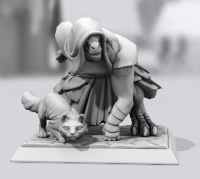Blind Roll (requires Stylus for GM) So I posted something similar to this over in the Stylening thread a while back, but some recent messing about with nesting templates inside buttons got me thinking there must be an easier way to do it. This trick requires that the GM has Stylus to work properly (otherwise they won't be able to see the blind roll). Otherwise, it pretty much works copied straight out of the box - you might just want to add skills to it. This certainly isn't cheat-proof. In the Stylening post I have a method for hiding the id of the element to make it harder for players to uncover the element, but it occurred to me afterwards that there's no way to hide from HTML inspection, so it's probably not worth putting any effort in to that side of it. Let's just assume your players aren't total jerks looking for ways to cheat, and are happy with the blind roll. The nature of the macro makes the tooltip information unavailable and avoids rolling 3D dice (because... obviously). It does show the roll expression for both player and DM, though - so you can see if someone is rolling with advantage or not, or if their bonus doesn't look right, or they suddenly have 200 proficiency bonus. So I've made this macro as simple as possible. The players don't need to do anything . The DM needs to: - install Stylus - create a Style approximately 3 lines long - run the macro The Stylus style (this one's pretty scary): #userscript-broll { display:inline!important; } And the macro, set up for Roll20 5e: **DM requests a blind roll:** [Roll for ?{Roll|Stealth|Strength|Dexterity|Constitution|Wisdom|Intelligence|Charisma}](`/w gm &amp;&lcub;template:default&rcub; &lcub;&lcub;name&equals;?{Roll} Check&rcub;&rcub; &lcub;&lcub;&commat;&lcub;selected|character_name&rcub; rolls...&equals;&quest;&lcub;Advantage|Normal,1d20|Advantage,2d20k1|Disadvantage,2d20kl1&rcub; + &commat;&lcub;selected|?{Roll}_bonus&rcub;&lsqb;Bonus&rsqb; + &commat;&lcub;selected|pb&rcub;&lsqb;Prof&rsqb;&rcub;&rcub; &lcub;&lcub;&equals;&lsqb;Result &equals; &rsqb;(&num;&quot; id&equals;&quot;broll&quot; style&equals;&quot;display:none&rpar;&lsqb;&lsqb;&lsqb;&lsqb;&lsqb;&quest;&lcub;Advantage&rcub;&rsqb;&rsqb;d1 + &commat;&lcub;selected|?{Roll}_bonus&rcub; + &commat;&lcub;selected|pb&rcub;&rsqb;&rsqb;&rsqb;(#&quot; id&equals;&quot;broll&quot; style&equals;&quot;display:none&rpar;&rcub;&rcub;" style="color:darkred;background-color:white;border:solid 2px darkred;font-size:17px;border-radius: 5px;padding:2px;display:inline-block) I've kept the Ability list short, I just did the primary Attributes for 5e then threw Stealth in for fun. Most skills are unlikely to see much blind action... I'd assume Stealth is the big one at most tables. To add skills for the 5e by Roll 20 sheet, all you need to change is the very first Query - put in the skills you want, in the order of usefulness you want. This could be as short as ?{Roll|Stealth|Perception}. Be mindful of Animal Handling & Sleight of Hand: you'll need to either have the underscores visible in the drop-down, or use a comma: |Animal Handling,animal_handling| For other systems, it might need some tweaking. You might need to get rid of the Advantage, or tweak how the Attributes are referenced: it's currently set up for 5e which is @{selected|<skillname>_bonus} . Some other tweaks which would be easy to apply: wrap the button inside a 5e template (npcaction or traits) to prettify it, or chuck a whisper Query in front of it ?{Whisper or public?|Public, |Alice,/w alice |Bob,/w bob |Carly,/w carly } . If you haven't popped your head into any of the threads where we've been poking around with nesting entire templates inside API command buttons, you may have noticed a handy little Stupid Trick inside this Stupid Trick - namely, using a Roll Query to fill in an Attribute reference. This is usually a big no-no, but in this case it works. We've escaped the absolute brains out of the Attribute reference, so it's just a jumble of escaped entities and unresolved Roll Queries. But we don't need it to be a working Attribute reference until an entire round of parsing has.... errr.... passed. It's a nifty little trick which does have a big downside - you have to manually click the button after it's created. But I can see it saving a ton of macro code in the right situation. Anyway, sing out if you need any help adapting this... I know it's hard to read. A tip if you want to make more sense of the macro: paste it into chat, then mouse-over the button it creates. Right click => Copy link location => paste into Notepad. The escaped HTML will all have been parsed into regular macro code, and the button its wrapped in will be gone. Much sanerer!





















